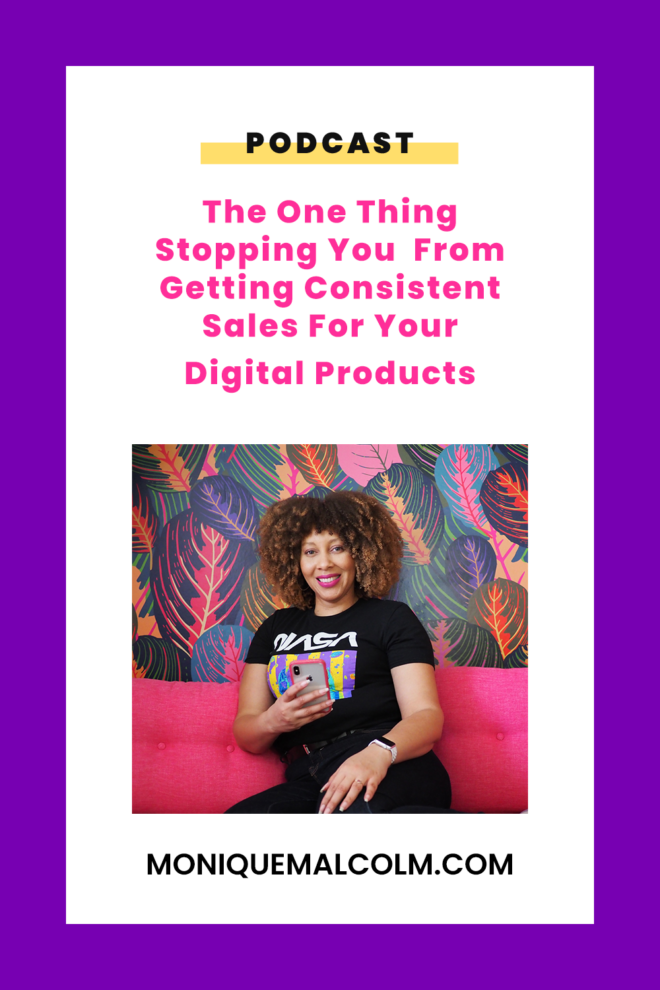
In episode 99, I talked about why you need to launch your digital product versus going straight to passive sales. The reason being that launching gives you the best chance at attracting buyers quickly especially if you have a new or small audience.
But what happens after the launch? How do you keep the sales rolling in? That’s what we’re going to talk about today. In this episode, I’m sharing the one thing stopping you from getting consistent sales and what you need to do about it.
Imagine for a moment, you’ve finished your first launch. You’re excited. You made a few sales. You’re finally feeling like this digital product thing might actually work. You have actual dollars from paying customers sitting in your bank account.
Now fast forward a few weeks, the initial excitement of the launch is over. You’re ready for more sales but you haven’t had a single one. What gives?
Most creative business owners selling digital products have no plan for making sales beyond the initial launch. They falsely believe that launching once is enough to open the floodgates of sales and keep it open. Unfortunately, it doesn’t work like that.
They’re then faced with the dilemma of either having to plan another launch OR start hustling to make sales. Both of which are time consuming.
There is a better way and it’s not difficult.
The one thing stopping you from making consistent sales for your digital product is your lack of a simple sales funnel.
What is a sales funnel?
Sales funnel sounds like a marketing buzzword but it’s not just another internet trend. A sales funnel is the process a potential customer goes through on the way to making a purchase.
Potential customers go into the top (or widest part) of the funnel and as they go through the different phases some drop off, but the people remaining at the end buy and become customers.
Your audience’s buying journey is rarely ever linear. Most people need multiple touch points (as many as 7) before making a purchase. This is why I encourage you to create content on various platforms and in multiple formats so that you’re everywhere your audience is hanging out online.
The Components of A Simple Sales Funnel
Your sales funnel does not have to be complicated (Remember my mantra K.I.S.S keep it simple solopreneur). A simple sales funnel for a digital product has 4 components: a compelling piece of content, lead magnet, email series, and a pitch.
Compelling Piece of Content – This is the entry point to your funnel. Your content is what attracts people interested in your specific topic or point of view.
Lead Magnet – Think of this as an ethical bribe. You’re giving a potential buyer a resource of value in exchange for their email address. Lead magnets take many different forms and can range from simple checklists to challenges.
Email Series – A series of emails that help a new subscriber get to know you and your business. The email series is a great time to tell your subscribers who you are and who you serve, that way if they aren’t a good fit they can unsubscribe themselves.
Pitch – This is where you make an offer and ask for the sale. The pitch is a very clear directive telling the potential buyer their next steps and how to take them.
Sales funnels tend to get a bad reputation online. Many creative business owners think of them as icky and spammy. However,

I personally don’t want people to feel duped into buying from me so I don’t use high pressure sales tactics. I treat my sales funnels as a way to deliver value to my audience while educating them on their problem and how my product is going to help them solve it. That’s not gross. That’s good marketing.
Why you need a sales funnel
Every creative business owner selling digital products needs a sales funnel in place to help turn website traffics into buyers.
Here’s why:
- Having a sales funnel helps simplify your marketing. Instead of trying to hustle for sales, you send your audience to the top of your funnel and let it work its magic. This is how passive income works.
- Website visitors may not browse deep enough into your site to find your digital products or services. That’s a wasted opportunity. Having a sales funnel in place ensures every interested potential customer is shown your offer.
- New website visitors are often not ready to make a purchase on the first visit. A key function of your sales funnel is to collect leads via a lead magnet so that you’ll have a way to follow up with that potential lead at a later time.
Sales funnels aren’t only smart to have, they’re necessary to have consistent sales.
Next steps…
So now that you understand what’s stopping you from getting consistent sales for your digital products, it’s time to put that information into action. Take your digital product and map out a sales funnel from beginning to end.
What compelling content are you creating to help people discover your business? What’s a valuable and relevant resource that you can offer as a lead? How can you nurture new email subscribers? What can you share to build the know, like, and trust factor?
If you need help building out your sales funnel, this is something that I cover in the Brilliance Lounge Community – membership is opening soon. Get on the waitlist and you’ll be the first to know once doors open.
Pin This:

